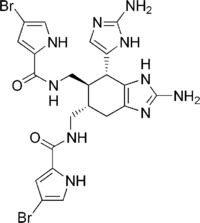Chemistry:Ageliferin
From HandWiki

| |
| Names | |
|---|---|
| Preferred IUPAC name
N,N′-{[(4R,5R,6S)-2-Amino-4-(2-amino-1H-imidazol-5-yl)-4,5,6,7-tetrahydro-1H-1,3-benzimidazole-5,6-diyl]bis(methylene)}bis(4-bromo-1H-pyrrole-2-carboxamide) | |
| Other names
Ageliferine
| |
| Identifiers | |
3D model (JSmol)
|
|
| ChEMBL | |
| ChemSpider | |
PubChem CID
|
|
| UNII | |
| |
| |
| Properties | |
| C22H24Br2N10O2 | |
| Molar mass | 620.310 g·mol−1 |
Except where otherwise noted, data are given for materials in their standard state (at 25 °C [77 °F], 100 kPa). | |
| Infobox references | |
Tracking categories (test):
Ageliferin is a chemical compound produced by some sponges. It was first isolated from Caribbean and then Okinawan marine sponges in the genus Agelas.[1][2][3] It often co-exists with the related compound sceptrin and other similar compounds. It has antibacterial properties and can cause biofilms to dissolve.[4]
See also
References
- ↑ Rinehart, Kenneth L (1990). "Bioactive Compounds from Aquatic and Terrestrial Sources". Journal of Natural Products 53 (4): 771–792. doi:10.1021/np50070a001. PMID 2095373.
- ↑ Keifer, Paul A. (1991). "Bioactive Bromopyrrole Metabolites from the Caribbean Sponge Agelas conifera". J. Org. Chem. 56 (9): 2965–75. doi:10.1021/jo00009a008.
- ↑ Kobayashi, Junichi (1990). "Ageliferins, potent actomyosin ATPase activators from the Okinawan marine sponge Agelas sp.". Tetrahedron 46 (16): 5579–86. doi:10.1016/S0040-4020(01)87756-5.
- ↑ Laura Sanders (2009). "Sponge's secret weapon restores antibiotics' power: Bacteria treated with compound lose their resistance". Science News 175 (6): 16. doi:10.1002/scin.2009.5591750616. http://www.sciencenews.org/view/generic/id/40894/title/Sponge%27s_secret_weapon_restores_antibiotics%27_power.
 |

